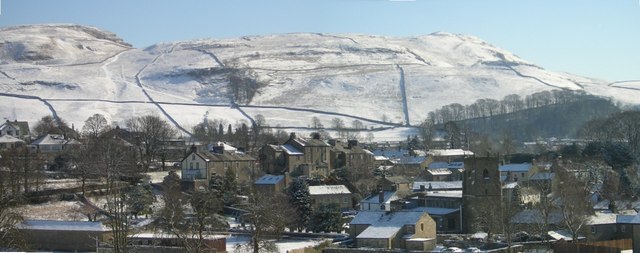The Yorkshire Portal
Yorkshire (/ˈjɔːrkʃər, -ʃɪər/ YORK-shər, -sheer) is an area of Northern England which was historically a county. Despite no longer being used for administration, Yorkshire retains a strong regional identity. The county was named after its original county town, the city of York.
The south-west of Yorkshire is densely populated, and includes the cities of Leeds, Sheffield, Bradford, Doncaster and Wakefield. The north and east of the county are more sparsely populated, however the north-east includes the southern part of the Teesside conurbation, and the port city of Kingston upon Hull is located in the south-east. York is located near the centre of the county. Yorkshire has a coastline to the North Sea to the east. The North York Moors occupy the north-east of the county, and the centre contains the Vale of Mowbray in the north and the Vale of York in the south. The west contains part of the Pennines, which form the Yorkshire Dales in the north-west. (Full article...)
Selected article

Stocksbridge Park Steels Football Club is a football club based in Stocksbridge, South Yorkshire, playing in the Northern Premier League Division One South. The club was formed in 1986 after a merger between two other clubs, and initially played in the Northern Counties East League. In the 1993–94 season the team won the championship of this league but were ineligible to gain promotion to the Northern Premier League as their stadium did not meet the required standard. Two seasons later Stocksbridge finished as Northern Counties East League runners-up and this time gained promotion to the Northern Premier League Division One, where the team remained until the division was regionalised in 2007. The team have twice reached the play-offs for promotion to the Premier Division but lost on both occasions. The Stocksbridge team wear a yellow and blue kit and play at the Look Local Stadium, which was known as the Bracken Moor Stadium until the club secured a sponsorship deal with a local newspaper in 2006. The stadium adjoins a cricket pitch and the club was required to erect a dividing fence in order to meet the requirements of the Northern Premier League. (read more . . . )
Selected image

Credit: Photograph by Chris Franks
Conisbrough Castle Keep is a 100 ft high circular keep, which is supported by six buttresses that dates to the 12th century. In the mid-1990s, the keep was restored, with a wooden roof and two floors rebuilt. (read more . . . )
Selected biography

Moore is best known for his abstract monumental bronzes which can be seen in many places around the world as public works of art. The subjects are usually abstractions of the human figure, typically mother-and-child or reclining figures. Apart from a flirtation with family groups in the 1950s, the subject is nearly always a woman. Characteristically, Moore's figures are pierced, or contain hollow places. Many interpret the undulating form of his reclining figures as references to the landscape and hills of Yorkshire where Moore was born.
His ability to satisfy large-scale commissions made him exceptionally wealthy towards the end of his life. However, he lived frugally and most of his wealth went to endow the Henry Moore Foundation, which continues to support education and promotion of the arts. (read more . . . )
Selected list -

Sheffield United played their inaugural league fixture as part of the Midland Counties League on 13 September 1890 against the now defunct Burton Wanderers. Since that game they have faced 115 different sides in league football with their most regular opponent having been Blackburn Rovers, against whom United have played on 142 occasions since their first meeting on 15 January 1894. As such United have registered more wins against the Lancashire side than any other, triumphing on 55 occasions. The most league defeats suffered by United have come against West Midlands team Aston Villa who have beaten them on 59 occasions, while the most draws have been registered against cross-city rivals Sheffield Wednesday with whom they have shared the points in 39 games. The most recent new league opponents for Sheffield United have been AFC Wimbledon, who they first met on 10 September 2016 in a League One fixture. (Full article...)
Selected Did You Know . . .

- ...that the Yorkshire Museum (pictured) paid £2.5 million pounds for an item found in Yorkshire using a metal detector?
- ...that Bradford City Football Club blamed their FA Cup exit in the 1919–20 season on a pre-game trip to Fry's chocolate works?
- ...that the charitable Sheffield Town Trust funded a cricket match which aimed to "prevent the infamous practice of throwing at cocks"?
- ... that when three men wearing gloves, masks and balaclavas were found on the roof of a church missing £100,000 worth of lead, they were let off because police said they "might be there just for the view"?
General images -
Subcategories
Selected panorama
Topics
Related portals
WikiProjects
Things you can do
Associated Wikimedia
The following Wikimedia Foundation sister projects provide more on this subject:
-
Commons
Free media repository -
Wikibooks
Free textbooks and manuals -
Wikidata
Free knowledge base -
Wikinews
Free-content news -
Wikiquote
Collection of quotations -
Wikisource
Free-content library -
Wikiversity
Free learning tools -
Wikivoyage
Free travel guide -
Wiktionary
Dictionary and thesaurus




















































